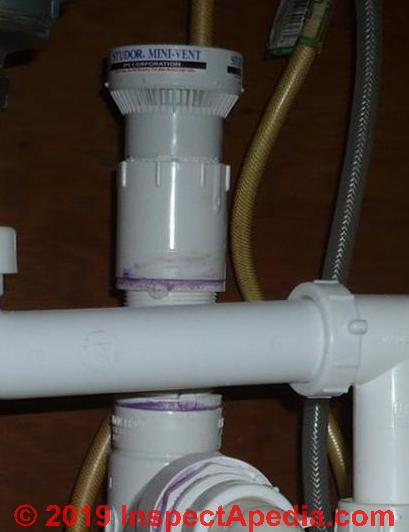

- WHERE TO INSTALL AN AIR ADMITTANCE VALVE FOR TOILET HOW TO
- WHERE TO INSTALL AN AIR ADMITTANCE VALVE FOR TOILET CODE
This venting option entails installing a vent to the vertical part of the waste pipe before the long-sweep elbow with a reducing wye. The vent pipe is then glued to the port that would be facing upwards. A sanitary tee makes the waste connection and its sweep is directed towards the sewer. A vertical vent is then extended from this point upwards and into the roof for it to have an open end.


Most toilets are built with the drain pipe running for a short distance before it drops towards the sewer in a vertical manner. Here are the most common ways of venting a toilet: 1. There aren’t any regulations that are against setting them up so far. They are very common in the US, Europe and other parts of the world. Ventless toilets have grown in popularity as it is difficult to set up standard venting.ĪAV is a simpler mechanism that has similar impact with the old venting pipes system. Rumor has it that AAVs are inconsistent and illicit, but you have to give it a fair shot before giving it a thumbs down. You can vent your toilet without a vent using an air admittance valve, also known as a cheater vent.
WHERE TO INSTALL AN AIR ADMITTANCE VALVE FOR TOILET CODE
Set in your area by the Uniform Plumbing code (UPC), and the international plumbing code (IPC).ĭon’t beat up yourself on the off-chance that you have moved into a rental that doesn’t have a toilet vent. A recent survey among readers of PM Engineer magazine revealed that 74 percent would consider the use of AAVs for venting systems, while 52 percent said they would use AAVs anywhere the code would allow. Trusted Source AAVs in the UPC? | | Plumbing & Mechanical Proponents of air admittance valves want them added to the UPC code, but they face resistance from those who remain unconvinced. There are many different ways of venting a toilet and certain aspects come into play like the size of the pipes, the design of the toilet, and the regulations In a nutshell, you can tell if your toilet has poor venting if it doesn’t flush properly, has bubbles in the bowl, or the water in the bowl rises and falls. Poor venting causes air to build up under the P-trap which in turn pushes or sucks water in the bowl. It should always be at a constant level at the bottom of the P-trap. Helps Maintain a Constant Water Level in the Toilet BowlĪs mentioned above, the water in your toilet’s bowl plays a critical role of preventing sewer gases from the drainage to flow into your home. The bubbles are just air that forces itself back into the bowl when it lacks a way to escape to the outside. Air bubbles in your toilet tank are a telltale sign of poor venting. When not in use, your toilet should be still without any bubbles or running water. Obstruction could be a clog which may delay flushing, or lack of venting which may cause a large bubble flowing out of the bowl as the waste flows down to the drain.

This process is hampered if there is any obstruction in the drain. The water forces its way into the drain past the p-trap. Proper venting releases water into your toilet bowl at a very high pressure. Here is why your toilet needs venting: Allows for Proper Flushing The gases must be released to avoid clogging the toilet’s system and that’s how venting comes in. The pool of water at the base of your toilet bowl plays the crucial role of sealing the drainage system so that awful smelling gases don’t flow into the house.
WHERE TO INSTALL AN AIR ADMITTANCE VALVE FOR TOILET HOW TO
This article has all the information on how to vent a toilet without a vent. But what happens if your vent blocks or you move into a rental with a ventless toilet? Yes! Ventless toilets are increasingly gaining notoriety. Without a vent a toilet is literally a closed system. Venting a toilet is a necessity, otherwise you will have an unbearable stench in your home. A proper venting mechanism provides a balance of pressure between the gases and the waste matter, allowing the waste matter to flow to the drain and the gases to escape. Your toilet’s venting mechanism is based on the nature of liquids and gases. Learn more about our process hereĪll toilets, be it one-piece, two-piece, or the smart models come with a setup that ensures they flush properly, prevent clogging, and entry of sewer gases that cause odor in the home. We may earn a commission through products purchased using links on this page.


 0 kommentar(er)
0 kommentar(er)
